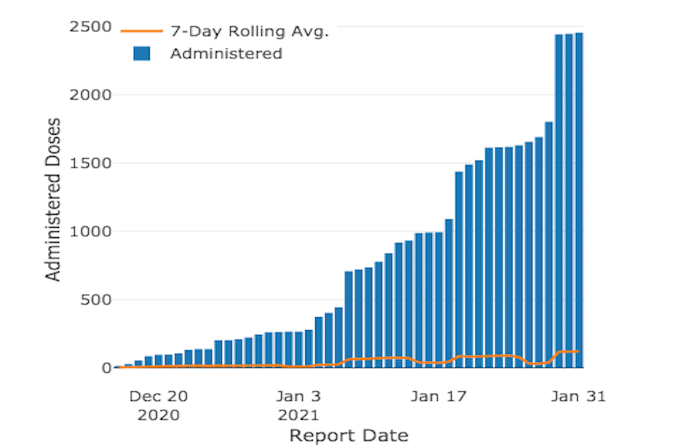Where’s your vaccine?

Although over 32.8 million Americans have received at least one shot of the COVID-19 vaccine, the rollout of this key pandemic-ending tool has been marked by confusion and frustration.
Individuals and government officials at every level have voiced complaints about the slow process of getting the over 200 million people eligible for the vacaine at least a chance to get vaccinated against a virus that has killed over 440,000 Americans.
To help provide more understanding about the largest vaccination effort in U.S. history, the Republic-Times has compiled answers to some frequently asked questions about the vaccination process.
Many of these questions do not have clear-cut answers, but even these partial answers may help ease frustration.
Why is the vaccine rollout taking so long?
This seemingly simple question is the one on everyones’ minds, and it has a complex and incomplete answer.
The most succinct answer has been supplied by White House COVID-19 Response Team Senior Advisor Andy Slavitt in a televised interview.
“We are facing two constraining factors,” Slavitt explained. “The first is getting enough supply quickly enough. And the second is the ability to administer the vaccine quickly once they’re produced and sent out to the sites.”
What are the problems facing supply?
All levels of government have been blamed for supply issues, though state and federal governments bear most of the responsibility.
After the Food and Drug Administration gave the two vaccines emergency use authorization, the Trump Administration spent billions to order 400 million doses total of the Pfizer-BioNTech and Moderna shots.
Other countries, perhaps most notably the European Union, have also ordered large quantities of vaccines.
Production is accelerating and the Biden Administration announced last week it was buying an additional 200 million doses of vaccines, but the companies have already been working around the clock to produce as much of the shots as possible.
Therefore, experts and government officials have said it will be months, at best, before everyone who wants a vaccine has access to it.
In Illinois, Gov. JB Pritzker has said the lag in the state’s vaccinations is because of a slow delivery process from the federal government.
“The current national vaccine supply pipeline is completely inadequate for national demand – a product of the previous presidential administration, whether or not you’d like to name it as such,” Pritzker wrote in a letter to Illinois Republican lawmakers.
In a virtual town hall event last Tuesday held by three regional organizations including the United Congregations of Metro East, Illinois Department of Public Health Director Dr. Ngozi Ezike also pointed to the federal supply as the issue facing the state.
“The sad news is we don’t have enough,” she said, adding the state got just 126,000 doses that day. “I can’t make vaccine. I don’t have anything I can do besides put out the vaccine that we get, and it’s just a little trickle for this large amount of people. I really need people to understand that so they can be patient.”
But the state’s vaccination efforts have not been unblemished.
As of last Thursday, Illinois ranked 47th in the nation in terms of overall vaccine distribution, with just 1.4 percent of the population being fully vaccinated and only roughly 6.5 percent of residents having gotten one shot.
That led to Illinois Senate Republicans to send Pritzker a letter, which prompted the aforementioned response, questioning the slow rollout.
“Why is the administration once again failing to lead during this crisis,” state Sen. Terri Bryant (R-Murphysboro) said. “The governor has chosen to act unilaterally in all decisions regarding the response to the pandemic and now, after months of suffering, we have a path forward to protect our vulnerable residents. Yet, vaccines are not being distributed. It is unacceptable. The governor needs to stop the blame game and provide real answers as to why Illinoisans do not have access to a vaccine.”
In Monroe County, Health Department Administrator John Wagner said “the problem is supply,” though he was not certain who was at fault for that.
Wagner, who already said he had to tangle with the state to get the county’s allotment upped to an equitable amount a few weeks ago, said part of the problem may be that the state is sending some of the vaccines to pharmacies to help spread out vaccination sites.
He said 95 percent of pharmacies, which can only vaccinate a few dozen people a day, offering the vaccine are in the northern part of the state, with only a handful of such options available to people south of Springfield.
Wagner said that was “not fair,” but could not unequivocally say it was to blame.
“I don’t want to blame the state because I don’t know everything about it,” he said. “The federal government and the state government need to do a better job of getting this out to the people who can get it in people’s arms.”
What are the problems facing distribution?
This answer is much shorter, but also less clear.
Across the country, health officials have said underfunded public health resources have been taxed by this vaccination effort.
The last stimulus bill passed included $8 billion for vaccine distribution, and the Department of Health and Human Services had already provided $350 million for vaccine distribution.
Wagner said money is not the problem here.
“It’s not funding for me,” he said. “We live in a great community, so I’ve got a lot of volunteers out there.”
Other health officials have said inconsistent allotments and hesitancy among eligible people to get the shots have also contributed to distribution problems, with the IDPH pledging the gap between doses allotted and administered would disappear as more people become eligible.
“They’re not sitting in health departments, I can tell you that,” Wagner said of unused shots.
What can be done to help speed up this process?
Unfortunately, not much can be done.
Given the state of vaccine manufacturing, it is unlikely the U.S. will see a sizable uptick in vaccines for at least a few months, though the Biden Administration announced last week that states should start getting about 16 percent more of the shots after production improves.
A key to accelerating the process would be the FDA approving another vaccine, which may happen shortly after Johnson & Johnson announced Friday its vaccine was 72 percent effective in the U.S. and 66 percent effective overall at preventing moderate to severe COVID-19.
While less effective than the two current vaccines, which are over 90 percent effective, this shot has the benefits of requiring only one dose and does not require the cold storage the other two vaccines do.
Ezike said the more vaccines that become available, the better the state can quickly inoculate its residents.
Wagner also said he hoped the federal government would take a more active role in vaccine production.
“With the power of the federal government, you would think they would be able to set up a plant or something to help manufacture more of this stuff,” he said, adding he supported banning Massachusetts-based Moderna from shipping the vaccine overseas until more Americans get it because “it was our tax dollars and everything that helped pay for this.”
When will most people be able to get vaccinated?
With all these issues, the country has fallen behind its vaccination projections.
Only about 75 percent of the number of residents the Trump Administration said would get the shot in December actually did, and the Biden Administration has been criticized for not having an ambitious enough daily vaccination goal.
That means it will be some time before most people have access to the shot.
“It’s going to be many months,” Ezike said. “In the meantime, people need to just be patient and wear a mask because I still don’t want people to get sick when we’re pretty close.”
“(It’s) going to depend on how much vaccine we get,” Ezike added. “At this rate, it’s going to take beyond this year to get (residents vaccinated). I can’t control the supply chain, but I’m hoping we have enough to vaccinate everybody this year.”
To stay updated on when your group of people is eligible for the shot here, sign up for the county’s Code Red alerts, and pre-register on EMTrack when your group is up to guarantee yourself a shot.
Wagner emphasized it is imperative to vaccinate as many people as quickly as possible.
“Especially for the people 65 and above, this can be a life or death shot,” he said. “There’s high anxiety with that. A lot of the people I’m talking to, they don’t want to get the shot so they can go back around town or whatever, they just know that if they get this virus, they are more likely to die.”
“People are dying because we can’t get them the vaccine,” he summarized.






